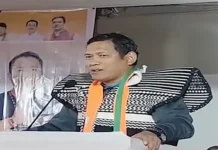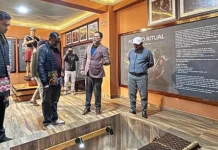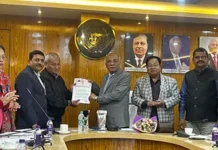[ Nani Bath ]
The Constituent Assembly members were in dilemma when they debated on the political future of tribal communities in India, particularly of India’s Northeast. On the one hand, tribal areas of the then ‘Greater Assam’ were aspiring for more political space, whereas political leaders and civil societies of ‘mainland Assam’ were totally opposed to such ideas.
The Constituent Assembly arrived at a ‘mean’ solution – neither too broad political space, nor too much of integration. With some opposition, the 6th Schedule was incorporated in the constitution of India. It was an extremely well-crafted constitutional mechanism to balance the desire of the tribal communities for more ‘political space’ with ‘self-autonomy’ and Assam’s stand against such demands.
The Autonomous District Council under the 6th Schedule has the power to make laws in respect of: allotment, occupation and use of land; management of forest; administration of justice; inheritance of property; control of money lending; trading by non-tribals, etc.
The constitutional scheme apparently worked well till an attempt was made to ‘impose’ Assamese as the official language of Assam in 1960, through what Sanjib Baruah calls the “aggressive cultural policies of the ethnic Assamese political leadership of undivided Assam.” As against such anti-hills policies, the hill tribal leaders hardened their postures by widening their area of demand – from more autonomy to creation of separate hill state, separating from the state of Assam.
In order to placate the hill leaders, Article 244 (A) was inserted by the Constitution (22nd Amendment) Act, 1969. It empowers the parliament to form autonomous state within the state of Assam, comprising all or any of the tribal areas under the 6th Schedule. The parliament is also empowered to create a body to function as legislature for the autonomous state or the council of ministers or both. In exercise of powers under this article, Meghalaya was created as an autonomous state within the state of Assam with separate legislature and the council of ministers, headed by the chief minister. The autonomous state of Meghalaya also had its representation (MLAs) in the legislative assembly of Assam.
After the 73rd and the 74th amendments to the constitution, every state was constitutionally required to introduce grassroots-level democratic institutions – panchayats and municipalities. However, as per Article 243 (M), the provisions under the 73rd Amendment Act, 1992, shall not operate in the tribal areas under the 6th Schedule and in the hill areas of the state of Manipur. Article 243 (Z) (C) provides that the tribal areas under the 6th Schedule are excluded from the operation of the Constitution (74th Amendment) Act, 1992, relating to municipalities.
Reservation of seats for Scheduled Tribes in the legislative assemblies of the states is provided in Article 332 of the constitution. The seats so reserved shall bear the same proportion to the total number of seats in the assembly as the population of the Scheduled Tribes in the state. Article 332 (A), however, gives exception to the states of Arunachal Pradesh, Meghalaya, Mizoram and Nagaland. It stipulates that all the seats except one are required to be reserved for Scheduled Tribes.
A mathematical calculation would make our understanding more clear. But for Article 332 (A), Arunachal Pradesh, having an ST population of 64 percent, only 38 assembly seats should have been reserved for the Scheduled Tribes (64 percent of total 60 assembly seats).
An act, the Arunachal Pradesh Panchayati Raj Act, was passed in 1997 to conform to the provisions of the Constitution (73rd Amendment) Act, 1992. The act was not assented by the president of India as it did not provide provision for reservation of seats for Scheduled Castes. The logic put forward by the state government was that Arunachal Pradesh being cent percent tribal state, there cannot be any reservation provisions for the Scheduled Castes.
The deadlock was ended when the parliament passed the Constitution 83rd Amendment Act, 2000, which gives exception to the state of Arunachal Pradesh from the requirement of reservation for the Scheduled Castes.
With the slogan, ‘Detection, deletion and deportation’ of illegal migrants from Assam, the agitation led by the All Assam Students’ Union continued for six long years. The movement was marked by ethnic violence, political instability, boycott of elections and call for ‘sovereign Asom’.
On 15 August, 1985, a Memorandum of Settlement, known as the Assam Accord, was signed between the then Rajiv Gandhi (Congress) government and the leaders of the movement.
The accord, inter alia, prescribed the lawful detection, deletion and expulsion of ‘foreigners who came to Assam on or after 25 March, 1971’ and the provision of ‘constitutional, legislative, and administrative safeguards’ and to ‘protect, preserve and promote the cultural, social, linguistic identity and heritage of the Assamese people.’
Accordingly, the Citizenship Act, 1955, was amended and Section 6 (A) (unique to Assam) was inserted. It stipulates that every person of Indian origin who entered Assam between 1966 and 1971 and are detected as ‘foreigners’ shall be denied right of franchise for 10 years. After the expiry of ten years, they are to be registered again as citizens.
The government of India, under Atal Bihari Vajpayee, acknowledged a historical fact that ‘Nagaland has a unique history.’ Continuing with such acknowledgements, the Narendra Modi government signed a ‘Framework of Agreement’ with the NSCN (IM) in 2015, contents of which are still shrouded in mystery.
The Naga National Council, under Angami Zapo Phizo, fought for a sovereign Naga country. There had been protracted fights between the ‘Naga National Army’ and the army of the republic of India. To give peace a chance, the Naga Peoples’ Conventions were held thrice (1957-59). The conventions were attended by representatives from various Naga sub-tribes, but the NNC was not a party to any of the conventions.
After the first convention, Tuengsang Frontier Division was separated from the North East Frontier Agency (now Arunachal Pradesh) to form the Naga Hills-Tuengsang Area. In 1960, an agreement was signed between the Naga Peoples’ Convention and the government of India. The agreement promised statehood to the Nagas. Thus, the Naga Hills-Tuengsang Area was renamed as Nagaland, which was made a state within the Indian Union in 1963.
As agreed, Article 371 (A) was inserted by the Constitution (13th Amendment) Act, 1962. It provides that no act of parliament in respect of religious and social practices of the Nagas, Naga customary laws and procedure, administration of civil and criminal justice and ownership and transfer of land and its resources, shall apply to the state of Nagaland unless the legislative assembly of Nagaland, by a resolution, so decides.
Declaration of independence was made by the Mizo National Front on 1 March, 1966. The cadres of the MNF took over various government establishments in the then Mizo Hills district, which led to the bombing of Aizawl and surrounding areas by using the Indian Air Force. After a long struggle, the MNF, led by Laldenga, came to the negotiating table.
An agreement, Memorandum of Settlement (Mizo Accord) was signed between the Mizo National Front and the government of India in 1986. As a part of this agreement, Article 371 (G) was inserted in the constitution of India in 1986.
Article 371 (G) is a carbon copy of Article 371 (A), except that the former article covered only ‘ownership and transfer of land’ and not its resources. Part B of Article 371 (A) gives special power to the governor of Nagaland with respect to law and order in the state. It is similar to article 371 (H), giving special responsibility to the governor of Arunachal Pradesh with respect to law and order.
Debating on Article 371 (H), the then prime minister, Rajiv Gandhi, expressed that this provision was necessary because of the ‘very sensitive’ location of Arunachal Pradesh. The Arunachal Pradesh legislative assembly passed a resolution in 2013, urging upon the union government to expeditiously amend Article 371 (H) at par with the provisions of Article 371 (A).
However, going against the assembly resolution of 2013, chief minister Pema Khandu said that “Article 371 (H) shall not be tinkered with.”
Besides constitutional protective provisions, there are legal provisions that protect land and its resources, and customary laws and practices. These include the Bengal Eastern Frontier Regulation, 1873, applicable to the states of Arunachal Pradesh, Mizoram and Nagaland. The Assam Frontier (Administration of Justice) Regulation, 1945, and the Administration ofJustice and Police in Naga Hills District Act, 1993, are protective laws for Arunachal Pradesh and Nagaland, respectively.
After amendment of Article 370 and abrogation of Article 35 (A) of the constitution, there are apprehensions that the incumbent government may dilute, if not abrogate, the special constitutional and legal provisions available to the tribal communities of India’s Northeast.
When we peep into the pages of history, our apprehensions grow louder. Rammanohar Lohia, a socialist, was arrested for entering restricted areas of the NEFA without a valid permit. Lohia, like Syama Prasad Mukherjee, stood for ‘One India, one law’.
Subramanyam Swami, a top BJP leader, keeps insisting that “Hindustan is an identity; Bharat is a republic,” But the constitution of India says that “India, that is Bharat, shall be a union of states.” What Swami needs to be reminded of is that each state has its own identity and there may even be multiple identities within a state. All identities may not be ‘Hindu identity’.
Union Home Minister Amit Shah assured the people of Northeast India that the Narendra Modi government “will not touch Article 371.” We may have faith in his words, but “in politics,” James Harold Wilson says, “a week is a long time.” (The author is Professor of Political Science, Rajiv Gandhi University, Rono Hills. He can be contacted at nanibath@rediffmail.com)



